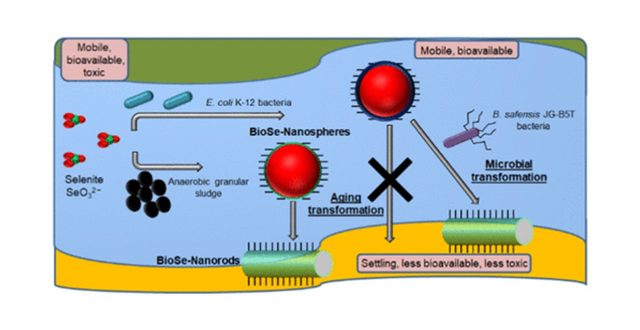The shape of nanomaterials affects their colloidal properties, cellular uptake, and fate in the environment. The microbial origin and microenvironment can play a role in altering the shape of the nanomaterial. However, such studies have never been conducted. Here, we demonstrate that the selenium nanomaterials produced by Escherichia coli K-12 are stable and remain as BioSe-Nanospheres under thermophilic conditions, while those produced by anaerobic granular sludge transform to BioSe-Nanorods, due to a lower quantity of proteins coating these nanoparticles, which has been verified by proteomics analysis as well as using chemically synthesized selenium nanomaterials. Furthermore, the presence of Bacillus safensis JG-B5T transform the purified BioSe-Nanospheres produced by E. coli K-12 to BioSe-Nanorods, though they are not transformed in the absence of B. safensis JG-B5T. This is due to the production of peptidases by B. safensis JG-B5T that cleaves the protein coating the BioSe-Nanospheres produced by E. coli K-12, leading to their transformation to trigonal BioSe-Nanorods, which is the thermodynamically more stable state. These findings suggest that the fate of selenium and probably other redox-active elements released from the biological wastewater treatment units needs to be reevaluated and improved by including microbial criteria for better accuracy.

Microbial Origin of Slenium Nanoparticle Determines Its Fate
WRHI Newsおすすめ
Published
(Laboratory for Zero-Carbon Energy / Dr. Satoru Tsushima)
“Impact of the Microbial Origin and Active Microenvironment on the Shape of Biogenic Elemental Selenium Nanomaterials”
Environmental Science and Technology (DOI: 10.1021/acs.est.0c07217)
For details, click here.
<Abstract>
